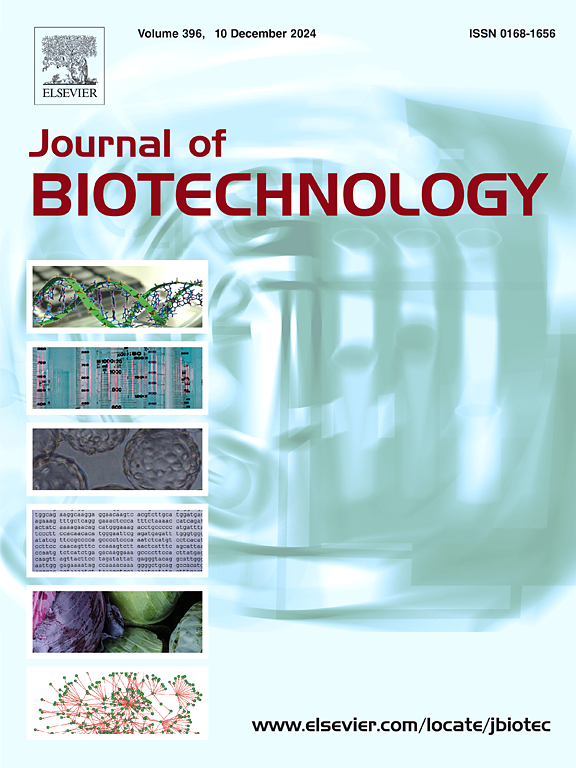渠道问题:通过环路工程克服扩散瓶颈,以提高异戊二烯的生产。
IF 3.9
2区 生物学
Q2 BIOTECHNOLOGY & APPLIED MICROBIOLOGY
引用次数: 0
摘要
选择性化学脱水导致C=C双键形成是一个具有挑战性的反应,具有巨大的工业应用潜力。脱香Castellaniella defragrans的辅助因子独立双功能芳樟醇脱水酶异构酶(LinD)催化(S)-芳樟醇可逆脱水为月桂烯,并异构为香叶醇。我们以前报道过LinD能够将小的2-甲基-3-丁烯-2-醇转化为有价值的产品异戊二烯。为了在一种新的重组大肠杆菌全细胞两相体系中促进lind催化异戊二烯的生产,我们通过酶工程瞄准了活性位点和假定底物通道附近的柔性α-螺旋。有趣的是,没有活性位点变异表现出增加的产物形成。对形成α-螺旋的10个氨基酸进行饱和诱变,发现K103N、R104G、G107T和D112T的产物形成量分别是野生型酶的1.73±0.05、1.56±0.12、2.08±0.12和1.93±0.06倍。值得注意的是,与相应的单点变异相比,针对这四个变异的组合方法在所有情况下都导致活性降低,表明负的上位性相互作用。因此,采用催化效率最高的单点变体G107T,其kcat (app)比野生型高28倍,利用全细胞两相体系获得了2.8±0.2mM的异戊二烯。晶体学分析显示G107T的结构变化很小;然而,分子动力学模拟揭示了相对于LinD野生型的显著构象差异,强调了底物通道改变在变体G107T中的作用。本文章由计算机程序翻译,如有差异,请以英文原文为准。
Channel matters: Overcoming diffusion bottlenecks via loop engineering of LinD for enhanced isoprene production
The selective chemical dehydration leading to C![]() C double bond formation is a challenging reaction that harbors great potential for industrial applications. The cofactor independent bifunctional linalool dehydratase isomerase (LinD) from Castellaniella defragrans catalyzes the reversible dehydration of (S)-linalool to myrcene, as well as its isomerization to geraniol. We previously reported that LinD is able to convert the small alkenol 2-methyl-3-buten-2-ol to the valuable product isoprene. To foster the LinD-catalyzed production of isoprene in a novel recombinant E. coli whole-cell two-phase system, we targeted the active site and a flexible α-helix near the putative substrate channel via enzyme engineering. Interestingly, none of the active site variants exhibited an increased product formation. In contrast, saturation mutagenesis of the 10 amino acids forming the α-helix, identified the variants K103N, R104G, G107T and D112T, which exhibited a 1.73 ± 0.05, 1.56 ± 0.12, 2.08 ± 0.12 and 1.93 ± 0.06-fold increase in product formation compared to the wild-type enzyme, respectively. Notably, a combinatorial approach targeting these four variants led to decreased activity in all cases, compared to the corresponding single-point variants, indicating negative epistatic interactions. Thus, employing the most catalytically efficient single point variant G107T, which exhibited a 28-fold higher kcat (app) compared to the wild-type, a total of 2.8 ± 0.2 mM isoprene was obtained utilizing the whole-cell two-phase system. Crystallographic analysis of G107T revealed only minor structural changes; however, molecular dynamic simulations uncovered striking conformational differences relative to the LinD wild-type, emphasizing the role of altered substrate channel in variant G107T.
C double bond formation is a challenging reaction that harbors great potential for industrial applications. The cofactor independent bifunctional linalool dehydratase isomerase (LinD) from Castellaniella defragrans catalyzes the reversible dehydration of (S)-linalool to myrcene, as well as its isomerization to geraniol. We previously reported that LinD is able to convert the small alkenol 2-methyl-3-buten-2-ol to the valuable product isoprene. To foster the LinD-catalyzed production of isoprene in a novel recombinant E. coli whole-cell two-phase system, we targeted the active site and a flexible α-helix near the putative substrate channel via enzyme engineering. Interestingly, none of the active site variants exhibited an increased product formation. In contrast, saturation mutagenesis of the 10 amino acids forming the α-helix, identified the variants K103N, R104G, G107T and D112T, which exhibited a 1.73 ± 0.05, 1.56 ± 0.12, 2.08 ± 0.12 and 1.93 ± 0.06-fold increase in product formation compared to the wild-type enzyme, respectively. Notably, a combinatorial approach targeting these four variants led to decreased activity in all cases, compared to the corresponding single-point variants, indicating negative epistatic interactions. Thus, employing the most catalytically efficient single point variant G107T, which exhibited a 28-fold higher kcat (app) compared to the wild-type, a total of 2.8 ± 0.2 mM isoprene was obtained utilizing the whole-cell two-phase system. Crystallographic analysis of G107T revealed only minor structural changes; however, molecular dynamic simulations uncovered striking conformational differences relative to the LinD wild-type, emphasizing the role of altered substrate channel in variant G107T.
求助全文
通过发布文献求助,成功后即可免费获取论文全文。
去求助
来源期刊

Journal of biotechnology
工程技术-生物工程与应用微生物
CiteScore
8.90
自引率
2.40%
发文量
190
审稿时长
45 days
期刊介绍:
The Journal of Biotechnology has an open access mirror journal, the Journal of Biotechnology: X, sharing the same aims and scope, editorial team, submission system and rigorous peer review.
The Journal provides a medium for the rapid publication of both full-length articles and short communications on novel and innovative aspects of biotechnology. The Journal will accept papers ranging from genetic or molecular biological positions to those covering biochemical, chemical or bioprocess engineering aspects as well as computer application of new software concepts, provided that in each case the material is directly relevant to biotechnological systems. Papers presenting information of a multidisciplinary nature that would not be suitable for publication in a journal devoted to a single discipline, are particularly welcome.
 求助内容:
求助内容: 应助结果提醒方式:
应助结果提醒方式:


